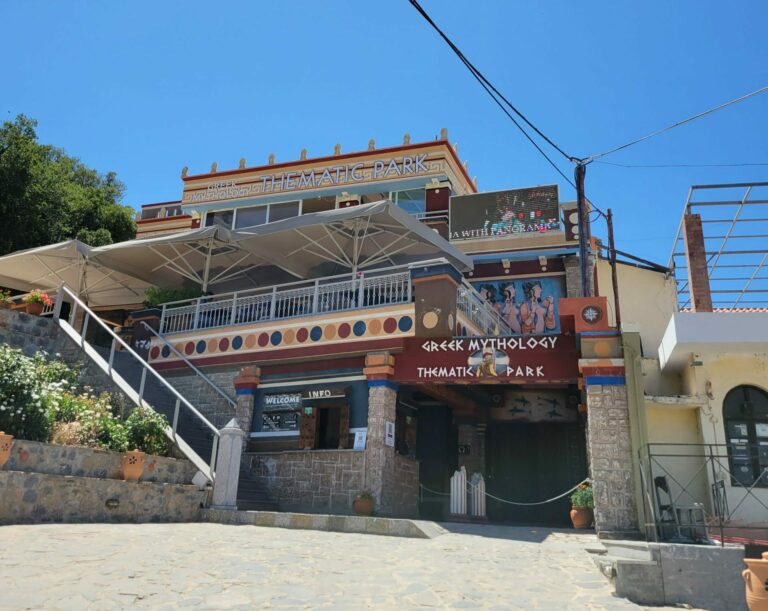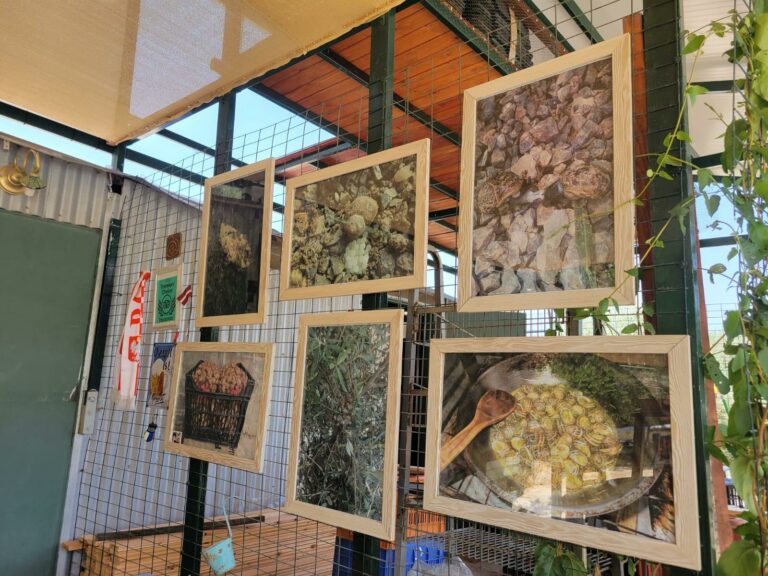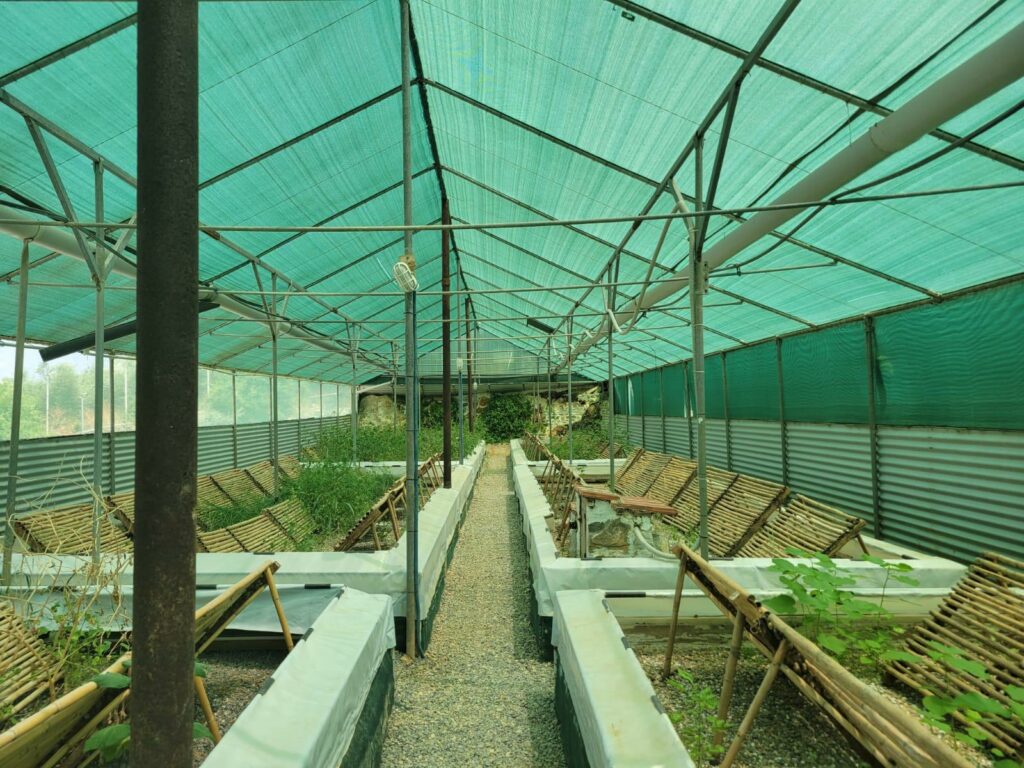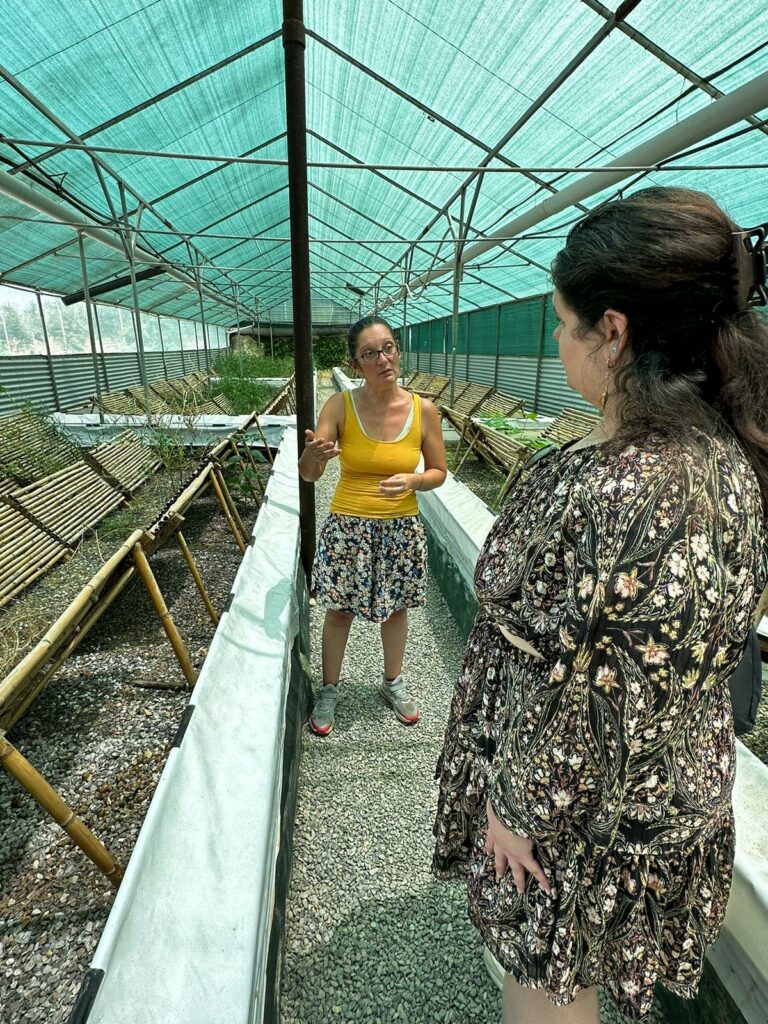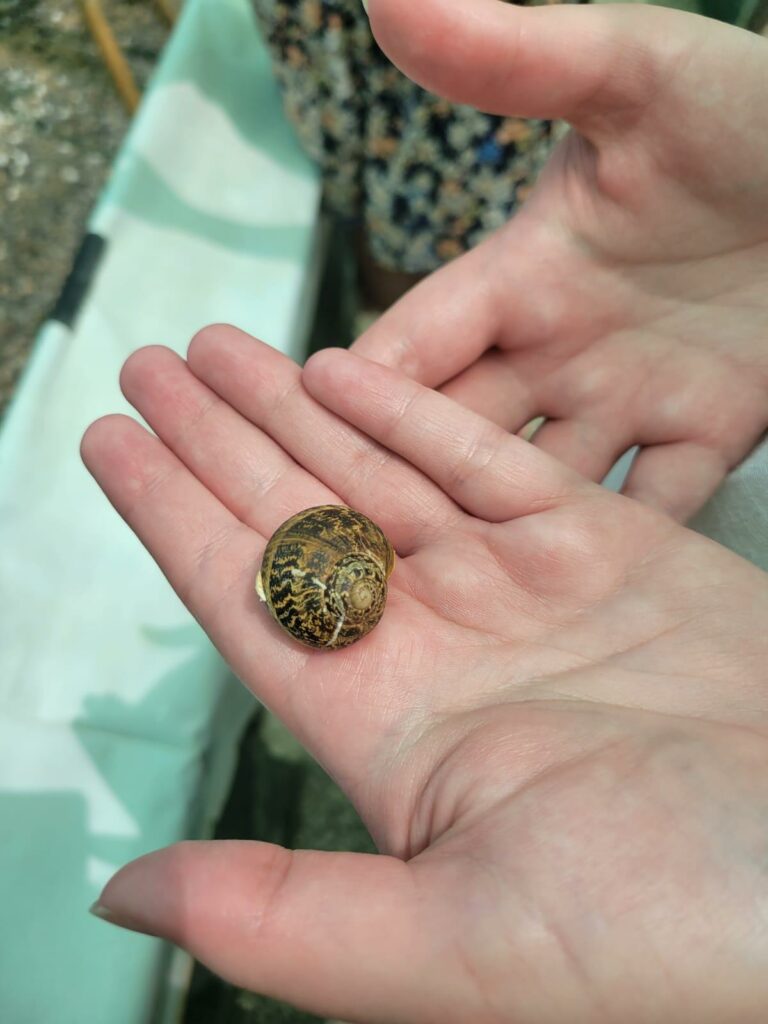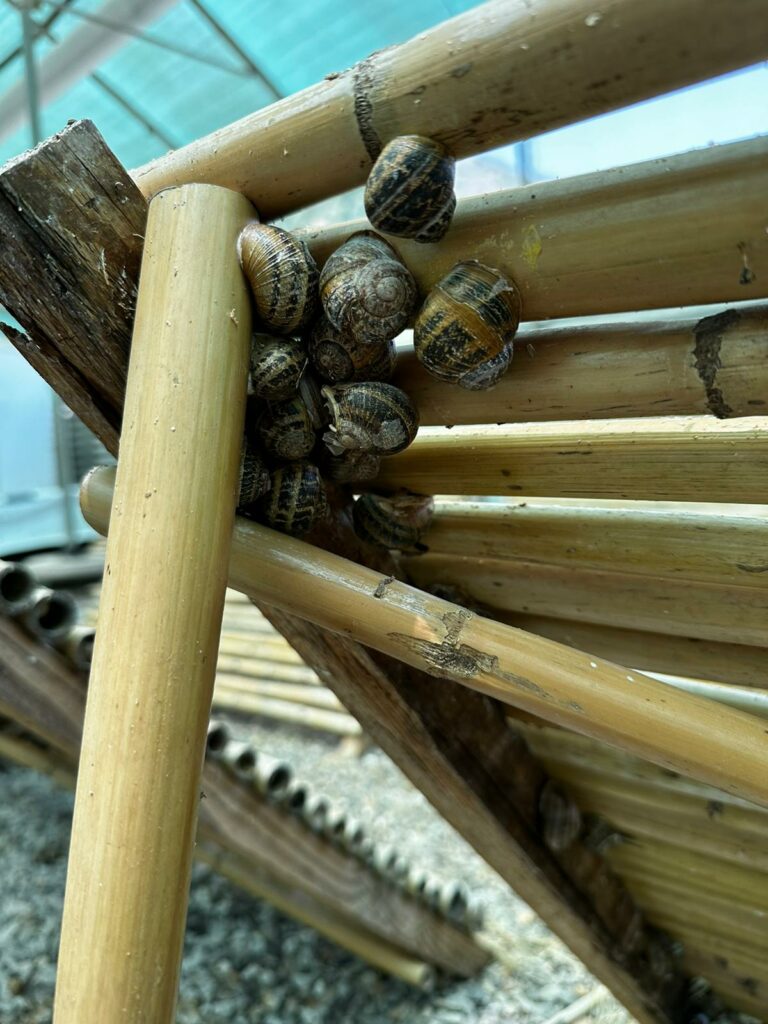It began, as most half-way decent stories do, with a misadventure in a small mountain town.

I woke that morning with a plan, a mission. I’d found out about a Museum of Musical Instruments thanks to a cursory google search, and as I am a great lover of music and a collector of instruments, (which I will one day learn to play, I promise), I really wanted to pay it a visit. The only problem? The museum was located in the small mountain town of Krousonas, and at this point in my travels I was not yet used to driving through mountain towns. The second problem, the fact that the museum closed at 2pm, was an afterthought. Still, it was my job to investigate the fun, lesser known activities around Crete, so I shoved my doubts about driving aside and grabbed my sister. Together, with my sister acting as navigator, we booted up the GPS, rolled up in my grandfather’s 1997 dark green Honda CR-V, and drove up into the mountains.
A word on Krousonas: I did not give it a fair shake. Not at all. I was there for one specific museum and was hyper-focused on trying to figure out where the hell I was supposed to park in this extremely residential area, and I panicked. My sister and I came to the conclusion that we’d have to walk, navigating streets far too small for even my grandfather’s ancient car, so I found a place I hoped I was allowed to park and did my best to ignore the judgmental eyes of the town’s elderly population, whose icy stares was enough to make the Mati turn it’s entire gaze my way. A fun personal note: I learned to parallel park that day, under the watchful eye of every Yiayia and Papou in a two-mile radius.
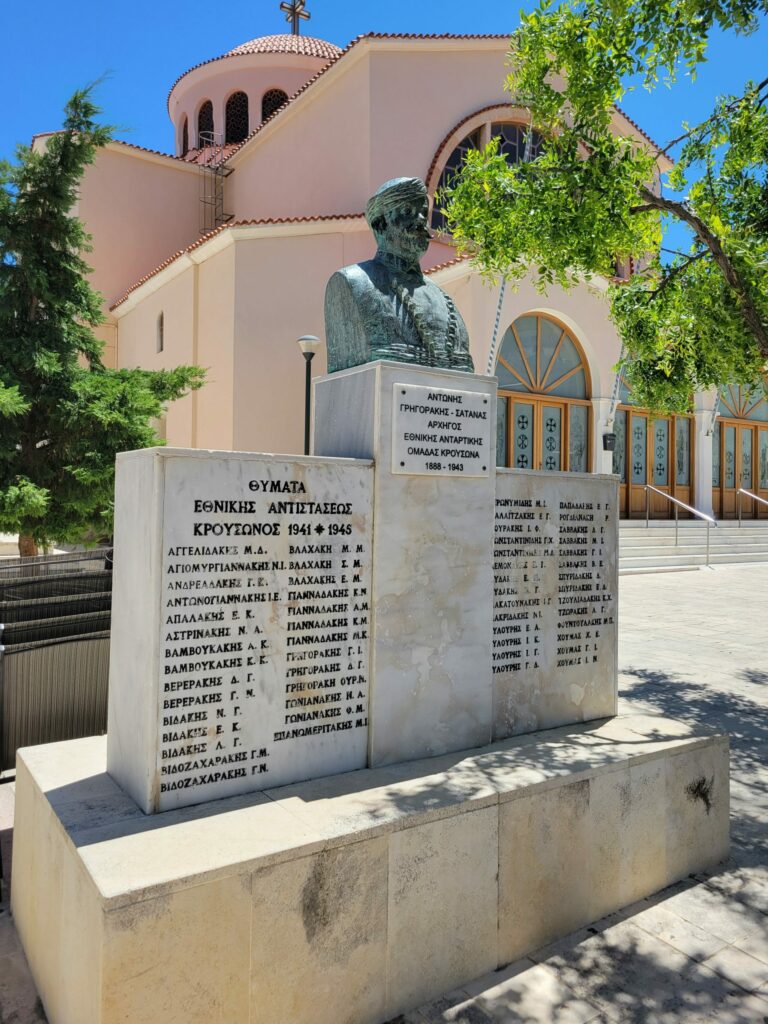
Krousonas is actually quite nice to look at, and quite picturesque. The mountain village is, for lack of a better word, authentic. If you truly want to see how the Greek people live, drive to a town like Krousonas, where few tourists know to venture. It’s complete with an atmosphere that lets you know that everyone who sees you knows you do not necessarily belong there, even if you’re used to passing for native Cretan in downtown Heraklion. If you look up Krousonas on wikipedia, you’ll only find how large it is, (25.109 sq mi), how many people live there, (2,564), and which municipality it belongs to, (Malevizi). None of this information helped us any as my sister and I hiked up and down the steeply inclined roads, our GPS leading us in circles. At one point we thought we had found it, but a quick peek through the windows led us to believe we were in danger of committing a home invasion accidentally, so we backtracked. We spent two hours in this manner, with a brief interlude where a kindly old woman tried to give me directions only for language-learning apps to fail me completely. Had she only asked me “where is the pink avocado?” or even “Where is the smoking camel?” perhaps we would have gotten somewhere, but a certain green owl had neglected to share the more vital phrases, such as directions, into my brain. After sweating our asses off until the museum was officially closed, we hiked back to the car in defeat.
Still, it wasn’t a complete loss: the local church was a gorgeous sight to see from the outside (I was not exactly dressed to go inside, so I settled on observing it from a distance). Just outside the church was a bust of who I first assumed was a figure-head, perhaps a local politician, before I noticed the name: Antonis Grigorakis – Satanas. I let out a poorly timed expletive and quickly took a picture, before sending it to my father to verify if it was in fact our distant relative and noted Cretan revolutionary. After a confirmation (and a confused flurry of texts asking why we were in the middle of a tiny village), my sister and I took turns taking selfies with our ancestor before sadly hopping back into the scorching, AC-less Honda CR-V.

I wasn’t sure what the next step was. What I wouldn’t give for a Me, someone who wrote incredible travel blogs that pointed visitors to Wine Dark Sea Villas in the right direction for interesting stops around Crete. But alas, there is only one me, and I had to do the hard work of having a great vacation. I was about to consider the day a wash and make it yet another beach day when my sister spoke up, reminding me about a theme park we’d seen ads for while at Dinosauria. The idea intrigued me. The ads had billed it as the first theme park centered around Greek mythology in all of Crete, and I am always ready to visit a theme park, no matter what kind it is. What would that look like? Would there be roller coasters, or would it be more of a walking fantasia? As the resident lover of the Creative and the Camp, I was down for anything.
I turned the key in the ignition and handed my sister the GPS, allowing her to lead us once more onto a new adventure.

Had I left directly from Villa Bella Mare, the drive would have taken me an hour and eleven minutes. It’s a fairly simple drive, following the A90 to the E75 to Malia, up into the mountains as the GPS leads you onward. In a standard rental, this drive isn’t an issue, and leads to some spectacular mountain views. The majestic Lasithi Plateau gets to shine in full force as the road’s sheer drops magnify the mountainsides, and as the sun sets, the colors reflected are some of the most gorgeous. However, I was not in a car that was really meant to be driving up mountains. In fact, if the check engine light was to be believed, I was not in a car that was meant to be driven at all. I really felt this as we began our uphill trek into the mountains, the sharp incline causing me to slam the gas so I wouldn’t fall backwards onto the cars behind. Dear God, I begged, please let everyone stop tailgating me, I am doing my best. Still, the drivers behind, who couldn’t know the struggle my poor Grandfather’s car was under, let their frustration be known until we were in a place safe enough where they could pass me, (or they simply lost their patience). After a 45 minute-eternity, white-knuckled and wondering if we had enough gas to get home, we pulled into the parking lot.

You may remember an article I wrote about Lasithi once before, where I hiked up and into the Dikteo Cave, famous in myth as being the cave of Zeus’s birth. So you can imagine my surprise when I realized I was in the exact same parking lot of said hike. We’d chosen a peak hour to visit, and were forced to drive to the parking lot by the souvenir shops. Though the parking was still free, we were asked very politely by the store owner to please be sure to purchase something from his shop in order to make up for it. As I am a lover of spending money on trinkets, I enthusiastically agreed, and we rounded the corner to the entrance of the Mythological Park.
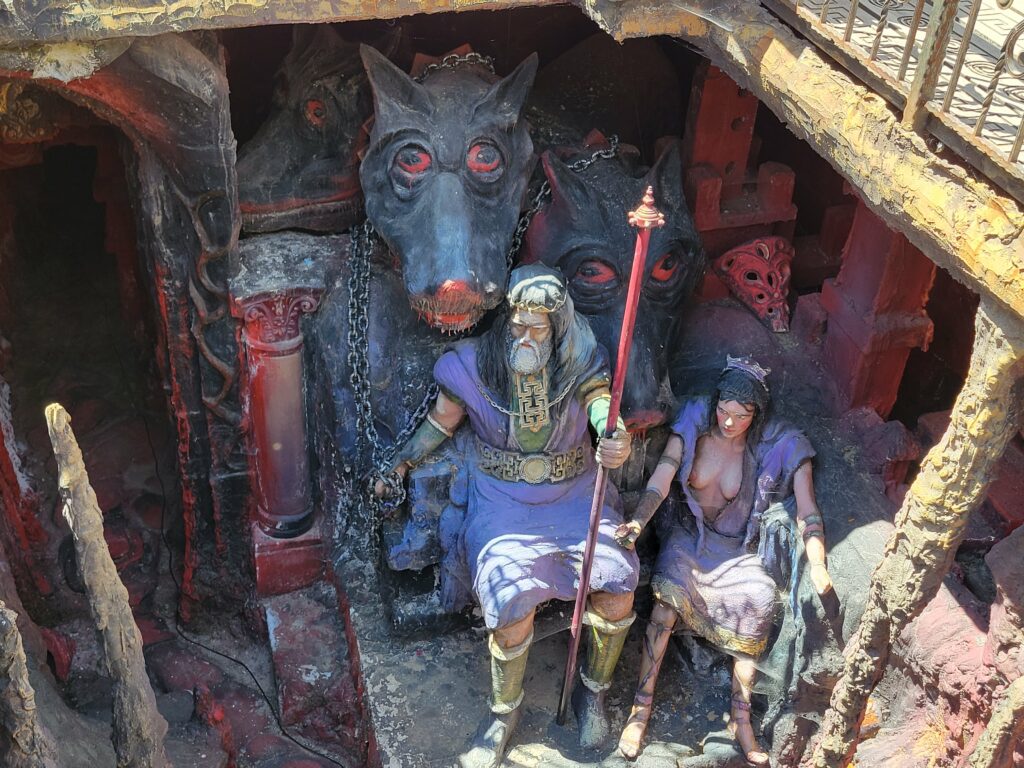
The enthusiastic worker at the front desk was very passionate about the park, and told me that it had been built in 2020. This was a 6 year passion project on the part of the Pitarokilis family, and is proudly the first mythological park in all of Greece, let alone Crete. Now, if you’re expecting rides, you may be disappointed: the Mythological Park is a walk-through exhibition, designed to immerse you in mythology, not to subject your body to 6 Gs and sudden drops. But what immersion! Every exhibit is a piece of mythology come to life, from the princess Ariadne who leads you into the labyrinth, a recreation of the palace of Knossos, to the great scene of Theseus slaying the Minotaur. Haunting audio thrills the imagination as you walk past tableaus of the sacking of Troy, of bull-jumpers, and Daedelus and Icarus taking flight. One of my favorite parts of this first chamber was the recreation of the infant Zeus, (who, if you remember, was born on Crete), whose cries were masked by two guards who clashed their swords as loud as they could to hide him from his father, Kronos. The immersion of the audio left quite the impression on me, and was the last interior exhibit seen before I stepped back out into the bright Cretan sunlight.
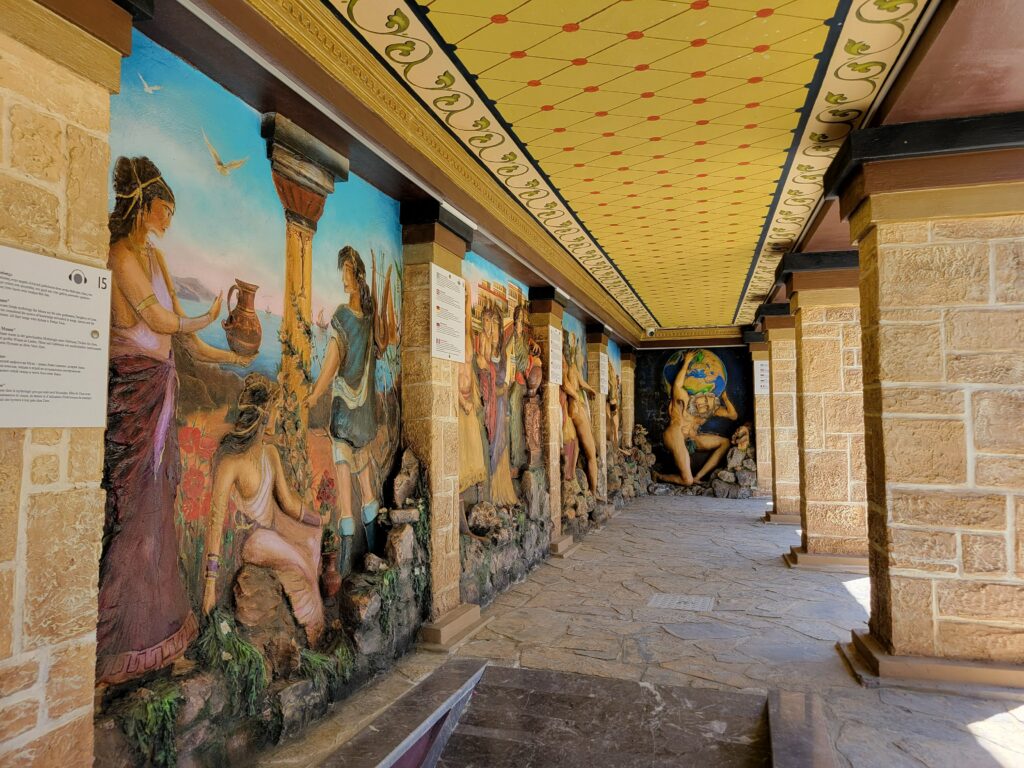
The park doesn’t end with the indoor tableaus. Instead, visitors are met with a grand sculpture of Zeus, with the surrounding walls detailing the Greek Pantheon and more scenes from mythology. It’s designed to look like a grand temple, though there is no roof. But the most interesting part is the large hole in the floor, surrounded by rod iron railings. Though you cannot descend, you can peer down into a gateway to the underworld, where the sounds of shades standing before Hades, Persephone (and a menacing Cerberus) echo in the cavern. I wish I could have descended into the Underworld for a closer look, but perhaps it’s best to leave such a descent to Orpheus or Heracles.

I continued walking around the outdoor temple for a while, the hot Cretan sun beating down on me mercilessly as I admired the reliefs and statues of Poseidon, the birth of the Minotaur, Atlas, and the nine muses. The path of the park is one way, and leads visitors through a giant pot, where the figure of Greek philosopher Diogenes resides with his faithful dog. For those unaware of one of history’s most intriguing minds, Diogenes was an irreverent philosopher who founded Cynicism. This large pot was a recreation (though perhaps an exaggeration) of the real clay wine jar he resided in. This exhibit marks a change in the mythological park from myth to reality: once you step out of the pot, you are transported to Crete in 1967.
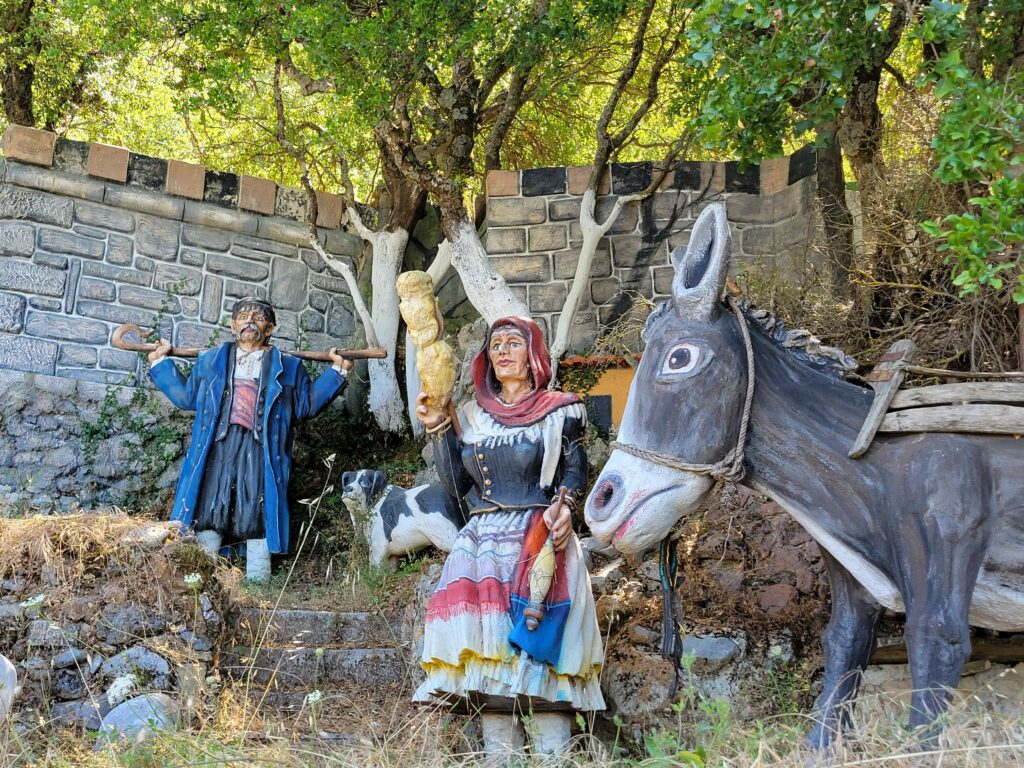
Designed to be a recreation of one of the many villages in the Lasithi Plateau, we are taken back to a time where the mountain agricultural lifestyle still reigned supreme. There is also, as a highlight, a gorgeous chapel that plays chants on a continuous loop. The art inside is a tribute to the Orthodox style of icons, and is complete with an altar and candles for prayer. You can even make a donation and light one yourself, as you sit and admire the beautiful cave-like chapel.
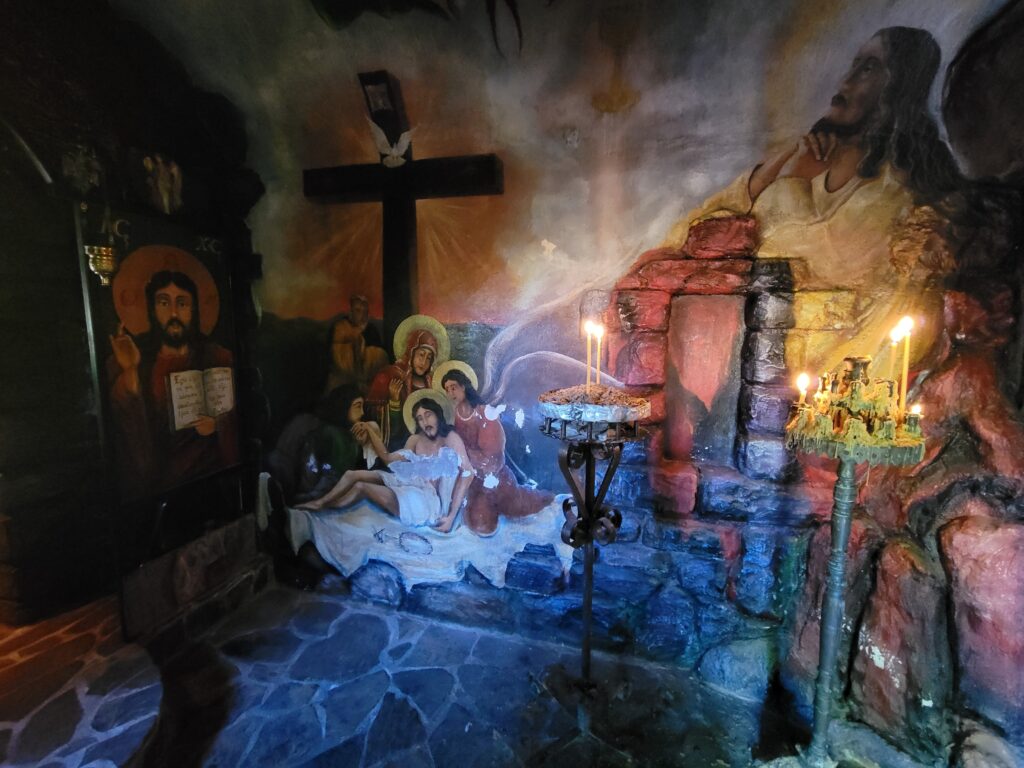
As you exit the park, following the path into the gift shop, visitors are greeted with one last mythological tableau: The Argo, Jason’s mythical ship, sailing to the Golden Fleece. The gift shop, coincidentally, contains souvenirs that come directly from the Pitarokilis family shop, and is full of statues, ceramics, olive oil products, and even some delightful raki (that I did purchase, and have since consumed with great fervor). We were then told that the larger shop was just a little ways down the mountain, and was impossible to miss: the storefront was lined with rows of windmills, telltale signs of Lasithi, and statues upon statues. This store was one I’d passed several times on my way to visit Zeus’s Cave in the past, and I was excited to pay it a visit at last. After bidding the Mythological Park a fond farewell, (and stopping to purchase a delightful rug from the store next door in accordance with our pact with the shopkeeper), my sister and I decided to stop at the Pitarokilis family store.
If ceramic souvenirs are what you’re hoping for, be it pottery recreations or statues, this is the place to shop. It is a deceptively enormous store, filled with incredible handmade works that seem to go on for miles. I wished in that moment that I was made of euros, for there were full sets of handcrafted bowls and plates I would have loved to return to the States with. Beautiful plaster statues of my favorite gods, including the lesser depicted ones, adorned shelves, taunting me by being just a little bit out of my price range. I got a demo of the famous Pythagoras cup, also available for purchase, before making my way to the back of the store. A ramp leads you further into the expansive store, this section exclusively for olive oil, karob, and raki products. Things in this section range from skin care to consumables, including some olive spreads I enthusiastically purchased, fantasizing about how I would enjoy them for breakfast for each remaining day of my vacation. The skin care section was even more incredible, with products that contained olive oils, dead sea salts, volcanic soils purporting to have special properties I no longer recall, and many more. I have been faithfully using the products I bought as my skincare routine, and I do have to say that my skin has never felt better. In times where I grow anxious about how I will continue my routine now that I am back in North America, I am comforted by the thought that they do, in fact, ship.

It was right around the point where I was disassociating from my incoming credit card bill that the woman who rang me out asked if we were interested in the pottery workshop. I had no idea what she was talking about, but my sister, who is an artist herself, was eager to learn. This was when we were led even further in the back, down some stairs into the Pitarokilis family workshop. Most, if not all, of the souvenirs sold in the shop (and in the gift shop of the Mythological Park), are made here, as were the exhibits found in the park. It was an exciting peak behind the curtain as we were led further in, our host taking us to the maestro potter who would be walking us through what to do.
For only 4 euros a person, you too can participate in this workshop. Don’t worry if you’ve never worked with clay before, or if the words ‘potter wheel’ strike fear into your heart. You’re guided through every (extremely messy) step, and by the end of it you’ll have your very own tiny vase or pot. I loved the feeling of manipulating the wet clay, as if I was reconnecting with some ancient part of my own Greek heritage. It was so incredibly tactile, so grounding to feel a part of wet earth take shape in my hands, even if they were being guided by someone much more experienced and talented than myself. After we were cleaned up, the maestro led my sister and I to a stalagmite-covered throne, and after he helped us into some togas, we took photos meant to evoke a Persephone-like energy. I feel like we came close.
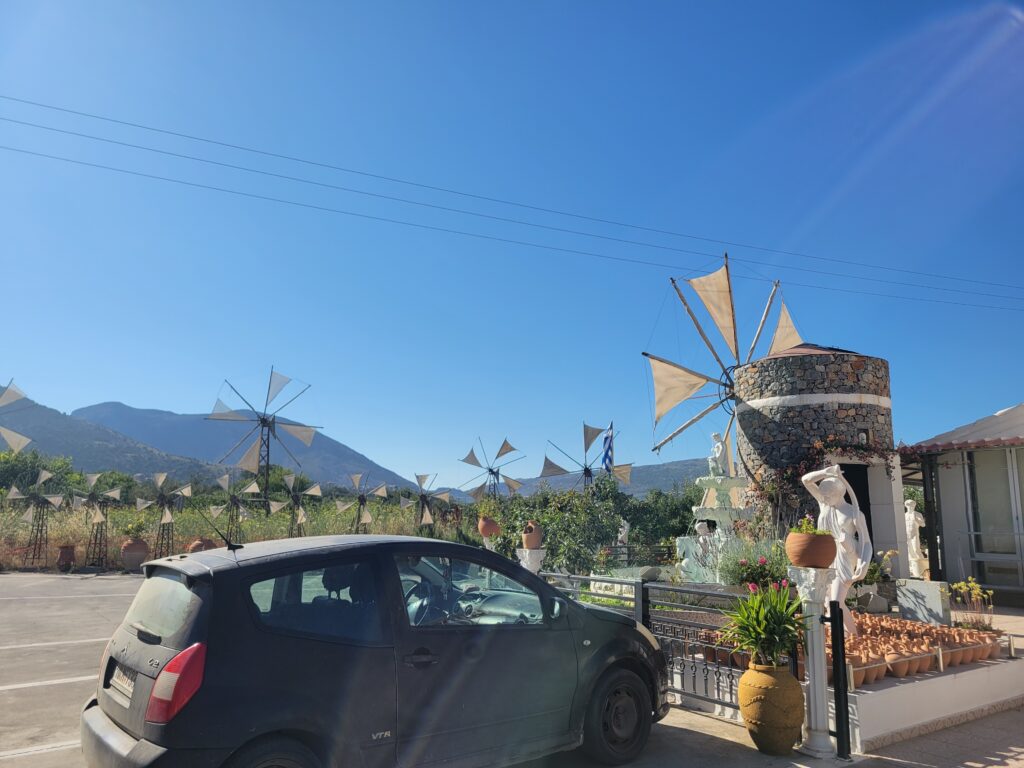
We packaged our tiny pots carefully, as they wouldn’t be completely dry for at least a day, and hopped back into our grandfather’s aged car for what we hoped would be an uneventful drive back to Villa Bella Mare. In the end, the only think remarkable about that drive was the sunset casting it’s fiery hues across the mountains, eventually making our way to where it turned the sea into a delicate purple. Perhaps Hephaestus had a hand in it, considering our day had been spent admiring the act of crafting. In the end, the misadventure had turned into an outright journey across the mountains of Crete, and we returned to our villa with a feeling of accomplishment.
Oh, and if you’re still curious about the Museum of Traditional Musical Instruments, never fear: it has since moved to downtown Heraklion, where the judgmental Papous are only judging you half as much as you think they are.
By Katarina Kapetanakis

